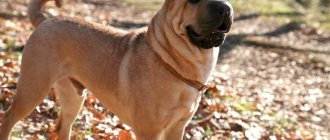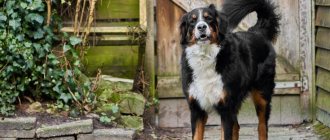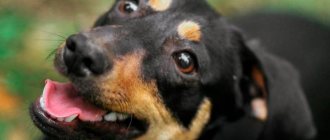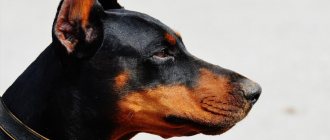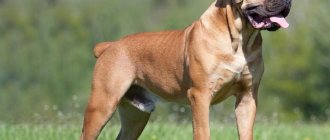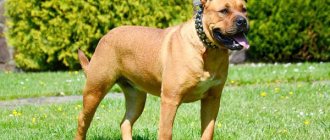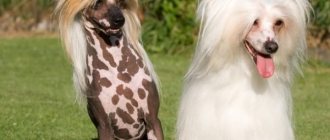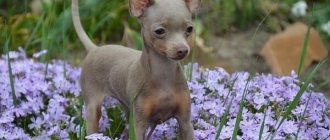The Shar Pei is a medium-sized dog with a very unusual appearance.
A characteristic feature of the breed is short, harsh hair and a complete absence of undercoat.
Another feature is the presence of deep folds in the skin, which make the Shar Pei unique.
The dog is distinguished by a powerful body, wide bones and a calm disposition.
The breed is also characterized by independence and devotion to all family members.
Life expectancy for boys and girls
How many years do Shar Peis live?
Despite its powerful build, the Shar Pei does not have a long life. On average, a dog lives about 10 years, but this figure can vary depending on various factors.
What you need to know:
- The average life expectancy of a female is 12 years, and that of a male is 10 years.
- With proper care and good maintenance, the maximum life expectancy for a female can reach 16 years, for a male - 14.
- The minimum life expectancy, under the same conditions, is for a female - 10 years, for a male - 8.
- If a dog suffers from genetic diseases, it will live on average 6–8 years.
Shar Pei girls live longer than boys, by about 2 years, and a sterilized dog lives less than the one that gave birth to puppies.
Expert opinion
Tolkachev Andrey Mikhailovich
veterinarian
“There are two factors that seriously affect the lifespan of Shar-Peis. The first is heredity, so when buying a puppy, inspect it carefully. The second is care and living conditions. If you do your best to meet the breed's needs, your dog can live up to 15 years. However, such a life expectancy is not typical for Shar-Peis.”
How long do Shar Peis live?
In general, the Shar Pei is a hardy and unpretentious dog; it can live a long time, up to 14 years or more, provided it has good exercise and is attentive to its health. Bitches have irregular heat cycles: the first one can occur even after 15 months. However, reproduction of dogs of this breed is not difficult; usually there are 3-4 puppies in a litter, sometimes six or more.
Shar Peis are known for their cleanliness and require minimal grooming. With regular care, the Shar Pei does not need to be washed and does not smell. Two or three times a week (more often during shedding), the dog must be brushed with a not too hard, but elastic enough brush to remove dead hair, then wipe the skin. If your dog has dry skin, you need to use a special oil or cream. It is also necessary to monitor the condition of the ears and eyes. Shar Pei's narrower ear canals compared to other dog breeds often cause ear diseases. The dog's face should be wiped after eating to prevent food particles from accumulating in the folds, which can become a source of infection and unpleasant odor.
The owner of a Shar Pei dog should not forget about the possible health problems inherent in this particular breed. The original population involved in breeding was very small, so almost all lines of Shar Pei can show hereditary diseases every now and then. The task of breeders is not to hide such cases, but to exclude dogs with certain disorders from breeding. One of the main scourges of Shar-Peis is entropy, or inward turning of the eyelids. As a result, the eyelashes scratch the cornea of the eye and injure it; this often ends in blindness. A puppy with such a defect in the eyelid has been rubbing his watery eyes with his paws since he was four weeks old. In order to save the eye, a veterinary surgeon must stitch the eyelids, but dogs with operated eyelids are not allowed to be bred.
Other diseases are related to the skin. Shar Pei skin is very sensitive. Food (such as soybean meal) or any environmental factor (pollen, dust, mold, detergents or flea products) can cause allergies in particularly sensitive individuals, which can manifest themselves in varying degrees: from redness of the skin to hair loss, accompanied by itching and weeping ulcers. The cause may also be insufficient function of the thyroid gland (hypothyroidism), to which Shar-Peis of some lines are predisposed. Redness and scratching on the skin can also be caused by the characteristic coat of the Shar Pei: hairs in the folds irritate the skin. Other diseases that these dogs experience include immune system imbalances, inner ear diseases, and gastrointestinal disorders. Adult Shar Peis are predisposed to the formation of tumors, the appearance of which must be detected as early as possible.
Age compared to human years
| Dog age | Dog age by human standards |
| 1 | 15 |
| 2 | 24 |
| 3 | 29 |
| 4 | 34 |
| 5 | 37 |
| 6 | 42 |
| 7 | 47 |
| 8 | 51 |
| 9 | 56 |
| 10 | 60 |
| 11 | 65 |
| 12 | 69 |
| 13 | 74 |
| 14 | 78 |
| 15 | 83 |
| 16 | 87 |
How to determine the age of a Shar Pei?
Criteria by which you can determine the age of a dog:
- Condition of teeth. A young dog's teeth are white and have characteristic cusps. At 2 years old, the tubercles on the hooks of the lower jaw begin to wear off. At 4 years old, the tubercles on the upper toes wear off. At the age of 5, the tubercles on the incisors wear off and the teeth turn yellow. At 6 years old, all the incisors are quite worn out and it becomes difficult to determine the bite. At 8–10 years old, the crowns of the teeth are significantly worn out, the teeth are yellow, and the fangs are blunt. At older ages, teeth become loose and fall out.
- Muscle tone and activity. The muscles of a young dog are always toned and have good tone, while the pet is active and full of strength. An older dog experiences sagging muscles, the dog becomes lazy, and becomes overweight.
- Condition of the coat. The young dog's coat is clean and smooth. As it ages, it loses these qualities, becoming duller and dirty in appearance. Also, an elderly dog turns gray when exposed to the sea.
- Eyes. The young dog has clarity and sparkle in his eyes. In an older dog, the eyes become cloudy and dull, and eye diseases often appear.
Description of the breed
FCI Standard No. 309 dated April 14, 1999 Shar Pei Group 2 “Pinchers and Schnauzers, Molossians, Mountain and Swiss Cattle Dogs” Section 2 “Molossians”
The peculiarity of the breed is short, hard and bristly, straight hair with a complete absence of undercoat. The average length varies from 1 to 2.5 cm.
Any solid color is allowed, with the exception of pure white. The tail and back of the thighs are often a lighter shade. Darkening along the back and on the ears is allowed.
The height of an adult dog at the withers: from 44 cm to 51 cm.
This is an active, compact, strongly built dog, square in shape, medium in size. The folds on the head and withers, small ears and the “hippopotamian” muzzle give it a unique appearance. Males are larger and stronger than females.
Important proportions:
- the height from the withers to the ground approximately corresponds to the length of the body from the glenohumeral joint to the ischial tuberosity, especially in males;
- the length from the tip of the nose to the stop is approximately equal to the length from the stop to the occipital protuberance.
| HEAD | In relation to the body, the head looks somewhat larger, due to folds on the forehead and cheeks, turning into a moderate dewlap on the neck. |
| EYES | Dark, almond-shaped with a frowning expression. Light eye color is allowed in dogs of diluted colors. |
| NOSE | Large and wide, preferably black, but any other color consistent with the coat is acceptable. Wide, open nostrils. |
| MUZZLE | Wide from the base to the tip of the nose, without a hint of pointedness towards the nose. The lips and top of the muzzle are filled. A convexity at the base of the nose is allowed. |
| EARS | Very small, fairly dense, in the shape of an equilateral triangle, rounded at the ends, set high on the skull, the tips of the ears are directed towards the eyes, located above the eyes, widely spaced and close to the skull. Prick ears are highly unacceptable. |
| TEETH | The jaws are strong, with a perfect scissor bite, that is, the upper teeth closely overlap the lower teeth and are set perpendicular to the jaws. The thickness of the lower lip should not be excessive and interfere with the bite. |
| NECK | Moderate length, strong, well set on the shoulders. The folds of skin on the neck should not be excessive. |
| BREAST | Wide and deep, the depth of the chest reaches the elbows. |
| PAWS | Moderate size, compact, not loose. The joints on the fingers are well defined. Free from dewclaws. |
| TAIL | Thick and round at the base, tapering to a sharp point and set very high, this is a characteristic feature of the breed. The tail can be high and curved, or curled into a tight ring, thrown over the back, or to one side. |
| FRAME | Skin folds on the body of adult dogs are extremely undesirable, except at the withers and at the base of the tail, which indicates moderate folding. |
How long do Shar Peis live? The average life expectancy depends on the conditions of detention, but on average it is ten years.
Main causes of premature death
There can be many reasons for the early death of a Shar Pei.
NOTE!
One of them is hereditary Shar Pei fever. The disease is characteristic only of this breed and is a specific disorder of the immune system; 25% of Shar Peis suffering from fever do not live to see 3 years of age.
Other reasons:
- Upper airway obstruction . The reason is anatomical abnormalities characteristic of brachycephalic breeds.
- Mastocytoma is a malignant skin tumor. In the initial stages, the disease looks like a slight redness and even a specialist cannot always make the correct diagnosis.
- Streptococcal toxic shock syndrome . A characteristic manifestation is damage to large areas of the skin. Wounds appear on the affected areas, which tend to spread into the roughness. The second manifestation is sudden death.
- Adenocarcinoma is a malignant tumor of the intestine.
Advantages and disadvantages
A correctly and timely socialized Shar Pei has a large number of positive qualities:
- ideal for older people and anyone who prefers a leisurely, measured life;
- reacts relatively adequately to children, but may show aggression in response to their pranks;
- undemanding in care and unpretentious in maintenance;
- has not lost its protective qualities and is able to protect its owner.
When choosing this breed, you need to remember that Shar Pei belong to the category of very wayward, independent and self-confident dogs, therefore they can only get along with a strong-willed, but kind person. It is best to entrust animal training to professionals, which will inevitably lead to significant costs.
How to extend the life of a pet?
To keep your pet healthy and live long, follow these rules:
- When purchasing, choose only a strong and healthy puppy with a good exterior.
- Feed your pet only high-quality and balanced food, and he should be given vitamins and supplements with microelements.
- The pet must be vaccinated.
- Visit your veterinarian at least once every six months.
- Provide your dog with the necessary physical activity.
- Remember - the Shar Pei has no undercoat, the dog freezes in winter, and in summer it can get sunburned. Be sure to take this factor into account when walking.
- Take good care of your dog's skin and check it regularly for suspicious spots.
IMPORTANT!
Never overfeed your Shar Pei, as he is prone to obesity, and this has a detrimental effect on his joints and cardiovascular system.
Proper nutrition
If your dog is on a natural diet, then his menu must include:
- Raw meat and offal.
- Boiled sea fish.
- Eggs (2 times a week).
- Dairy products.
- Porridge (millet, rice, buckwheat or oatmeal).
- Fruits and vegetables.
An adult dog should receive an amount of food equal to 3.5% of its weight per day.
If you decide to feed your dog dry food, you should pay attention to the source of protein in it. The best option is veal or beef.
NOTE!
The feed should not contain corn, soy, wheat, animal fat, preservatives or dyes, and the amount of fat and protein should not exceed 25%.
Quality maintenance and care
Proper maintenance and care of a Shar Pei at home includes:
- Appropriate place. The dog's place in the house should be warm, cozy and suitable in size for the dog. It is best if the bedding is made of natural materials and not very soft. The place should provide the dog with a good view, but at the same time it should be protected from drafts.
- The dog should be brushed 2 times a week, bathed once every 2-3 months.
- Products and food for Shar Pei should be selected with special care due to the pet’s tendency to allergies.
- Be sure to give your dog vitamin complexes and food supplements with microelements.
- Clean and examine your pet's eyes daily. If purulent discharge appears, contact your veterinarian immediately.
- The dog's teeth should be brushed at least 3 times a week, as the breed is prone to the formation of tartar.
- The pet's ears are treated once a week, regardless of whether they are dirty or not.
- Your pet's nails should be trimmed as they grow. Use a special nail clipper with a limiter for this so as not to injure the dog.
Characteristics and abilities
Balanced, independent, loyal breed, attached to its family. The Shar Pei is characterized by calmness, independence, loyalty and absolute devotion to its owners. Characteristics of the breed include increased caution and distrust of strangers.
Deep-set eyes and limited peripheral vision often cause excessive fearfulness. Early socialization and proper training of a puppy can minimize the risk of getting an aggressive and unbalanced adult dog.
This is an amazingly intelligent dog, an excellent watchdog, and enjoys the company of people; He is generally very affectionate and also has one more advantage - puppies independently learn to keep the house clean!
How to care for an older dog?
What happens to Shar Pei in old age:
- The musculoskeletal system suffers, which means that walks should become calmer and shorter. In bad weather, you shouldn't stay outside at all. Say no to slides and jumping structures, as these may harm your pet.
- As dogs get older, their eyesight often deteriorates. Therefore, regularly examine your dog's eyes and take him to the veterinarian often. At the first signs of cataracts, your doctor may prescribe treatment or surgery. In addition, a visually impaired pet should only be walked on a leash.
- An older dog should be bathed less often, as its immunity weakens as it gets older, and the pet may catch a cold more easily. It may make sense to use dry shampoo.
- An older dog's character may change; pets often become capricious, jealous and suspicious. Therefore, sometimes it is worth allowing them a little liberties.
- There is an increased need for protein. Feed your older dog food that contains higher amounts of protein. On the packaging of such food you will definitely see the inscription “For older dogs”.
- Often, as a Shar Pei gets older, it becomes incontinent. Don't scold him for this. It's just that now you have to walk him 3-4 times a day.
IMPORTANT!
When caring for an elderly dog, you should definitely take age-related changes into account and create all the conditions to provide your pet with a dignified old age.
Breed characteristics of Shar Pei
This breed is a figment of the imagination of ancient Chinese breeders. This people, who consider dogs their food, do not have a variety of breeds. However, they did breed one working breed.
Shar Pei is a shepherd, watchman and guard all rolled into one. Its main purpose was to guard and drive herds, as well as to protect the property and life of its owners.
The peculiar appearance of these dogs suggests that with their numerous folds they are very vulnerable and are more suitable for keeping at home than for herding herds and fighting with wolves.
However, the originality of the Chinese was that they created a kind of armor for the dog from the folds. This dog has a skin that is not tall enough. It's like wearing clothes three sizes too big. While the enemy is pulling on a piece of skin, its owner has the opportunity to wriggle out and give a worthy rebuff.
It seems that the Shar Pei can jump out of its own skin.
These folds create another illusion - large sizes. This, of course, is not Koli fur, but still try to mentally smooth out the folds and you will get a smaller dog.
The breed was almost exterminated, but in the second half of the 20th century it was restored, acquiring a purebred line and its own standard. According to it, the average weight of a Shar Pei is from 18 to 25 kg; height - from 45 to 50 cm. Mentally smooth out the folds, and you will get a dog slightly smaller than average size.
However, the physique of this dog is strong, dense, square in shape, and its muzzle resembles the parameters of a hippopotamus. All these characteristics are directly related to the problem of determining the age limit.
